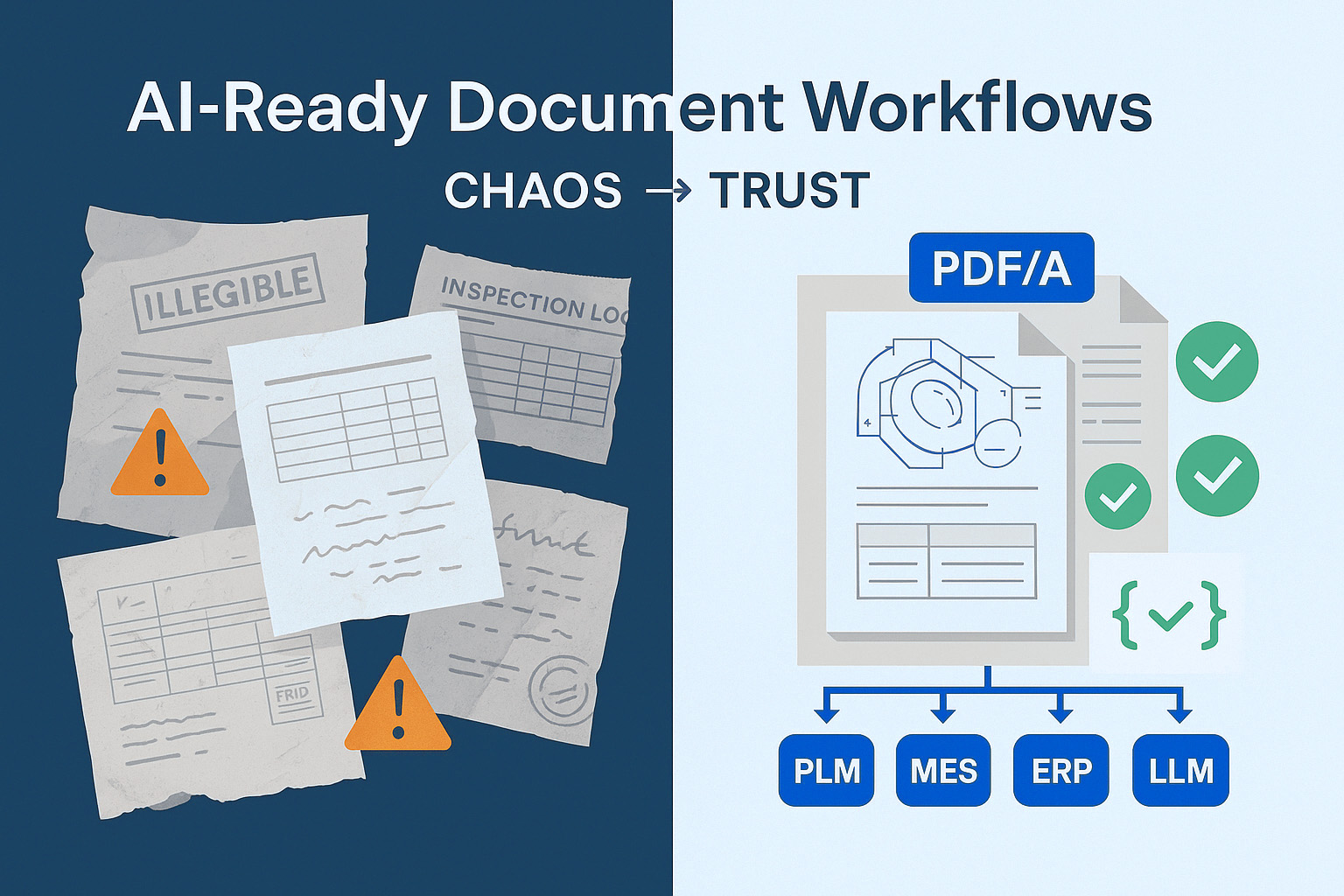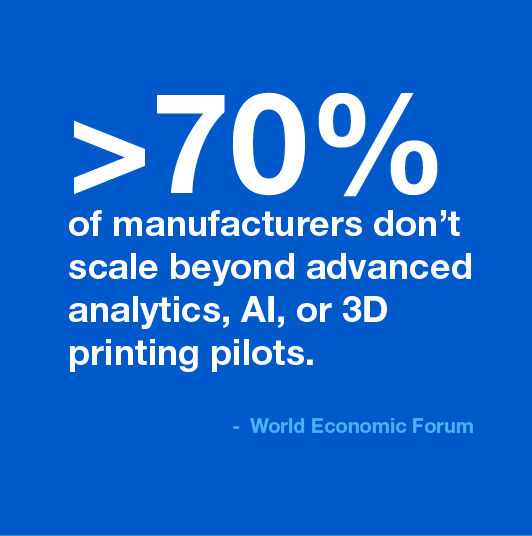The Last-Mile Fix for Smart Manufacturing: AI-Ready Document Workflows


Turn CAD, SOPs, and inspection logs into validated, AI-ready data. See workflows, use cases, and a 30-day rollout plan.

Most smart-factory programs don’t fail because the models are wrong. They stall because the inputs are.
Only 14% of manufacturers call their smart-factory deployments a success; data readiness is a top scaling challenge. - Capgemini’s Smart factories @ scale
60% of AI projects lacking AI-ready data will be abandoned by 2026. - Gartner
Engineering drawings, inspection logs, SOPs, batch records, supplier docs… when they arrive as scans, legacy formats, or fidelity-sensitive files, your PLM/MES/ERP and AI stacks can’t reliably read or trust them.
The cure isn’t “more AI.”
It’s an AI-ready document workflow that turns messy content into clean, contextual, validated data, continuously.
This article breaks down what “AI-ready” really means, how Adlib’s Transform platform operationalizes it, and where manufacturers are seeing results in the wild.
If you want digital twins, predictive maintenance, analytics, or LLM/RAG apps to behave, your documents must meet these outcome criteria:
Heterogeneous inputs (incl. legacy/CAD) are rendered into a consistent, faithful record format so structure, layers, and metadata remain intact.
Acceptance hint: target ≥99.5% visual fidelity; 100% metadata carry-through for required fields.
Each file exposes navigable text and layout structure (sections, tables, labels, bookmarks) so downstream systems can search, index, and compute.
Acceptance hint: ≥98% field/table capture on golden sets.
Content includes provenance, version lineage, and pass/fail checks against business or regulatory rules.
Acceptance hint: auditable trail for who/what/when; zero orphaned versions.
Documents and derived data move reliably into PLM, MES, ERP, ECM, data platforms, and vector stores via governed pipelines.
Acceptance hint: defined SLAs for latency and retry; deterministic routing.
Retrieval is grounded in verified sources with citations so answers are explainable and resilient to hallucinations.
Acceptance hint: every automated answer can point back to its source artifact.
AI-ready document workflow is an end-to-end process that converts unstructured manufacturing content (CAD, SOPs, inspection logs) into consistent, searchable, validated, and traceable outputs, then delivers both documents and structured data into PLM, MES, ERP, analytics, and LLM/RAG systems.

Pull documents from PLM/MES/ERP, ECM, email, shared drives, scanners, and supplier portals, capturing originals plus metadata and provenance.
Standardize heterogeneous inputs (incl. CAD/legacy) into consistent, pixel-perfect formats, often PDF/A for record of truth, while preserving vectors/PMI, layers, bookmarks, and critical metadata. This prevents layout surprises and broken references downstream.
Create a high-quality text layer with multi-engine OCR and classification; capture tables, fields, and entities; handle handwriting and multilingual layouts so formerly “scan-only” files become searchable, structured data.
Apply business/regulatory rules, version checks, and signatures. Use confidence thresholds to route only edge cases to human-in-the-loop review, keeping accuracy high without turning validation into a manual bottleneck.
Automate packaging and post-processing: merge/split, table of contents, bookmarks, stamps/watermarks, digital signatures, redaction, and PDF/A enforcement, so outputs are standardized and audit-ready.
Orchestrate end-to-end via configurable (often no/low-code) workflows; push documents and structured JSON/XML into PLM/MES/ERP, data lakes, and vector databases. When integrating AI, ground LLM/RAG apps in these verified sources to reduce hallucinations and improve explainability, while maintaining data sovereignty and avoiding lock-in.
The problem.
Digital twins drift when drawings lose vector fidelity/PMI, metadata, or version alignment. Supplier heterogeneity and legacy formats multiply the risk.
The workflow.
CAD → pixel-perfect PDF (preserving layers/annotations as needed) → extract BOM/spec attributes → validate against rules → register to PLM with full audit trail.
Why Adlib.
Proven CAD support and PLM connectors (e.g., Dassault, PTC) ensure fidelity and continuity, no rip-and-replace.
Real-life use case.
A global engineering leader standardized PLM-generated documents into universal PDFs and reported a 10% PLM efficiency lift, translating into significant downstream savings from fewer delays and errors.

The problem.
Multi-site ESG/quality packs are assembled manually from inconsistent source files, creating delays and audit risk.
The workflow.
Validate inputs against formats/policies → standardize to PDF/A plus JSON/XML → auto-assemble packs (TOC, bookmarks, stamps) → deliver to reporting systems with traceability and chain-of-custody.
Why Adlib.
Detailed audit trails, redaction/watermarking, and security certifications (e.g., SOC 2; FIPS-aligned practices) give teams confidence at inspection time and make the “document of record” unimpeachable.
Real-life use cases.
Regulated enterprises use Adlib to standardize and govern large volumes of controlled documents annually for submission and archival, keeping operations inspection-ready.
Pharma manufacturer minimizes compliance risk in batch delivery >
How Adlib powers supplier Quality Management and Compliance for a global aerospace leader >
The essential component in assuring global marine safety and compliance for a professional maritime services organization >
Nuclear agency ensures critical operations with Adlib's document automation >
The problem.
The right version doesn’t always reach the right cell, causing deviations, rework, and slowed change implementation.
The workflow.
Generate controlled PDFs, apply stamps/watermarks, enforce PDF/A, validate versions/signatures, and route to kiosks/cells with role-based access, logging who saw what, when.
Why Adlib.
No/low-code orchestration closes the gap between authoring and the line: design a rule once, apply it everywhere, and track acknowledgments programmatically.
Watch the full demo >
The problem.
Inspection and maintenance logs are scan-heavy, handwritten, and inconsistent. Valuable signals never reach MES or analytics in time.
The workflow.
Multi-engine OCR + classification → capture codes/measurements → validate against specs → push normalized data to MES/analytics and vector DBs for downstream consumption.
Why Adlib.
It converts “dark data” into searchable, structured signals without forcing technicians to change how they record observations.
Most customers run Adlib on-prem or in their own private cloud/VPC to maintain data sovereignty and support validated environments.
Containerized auto-scaling supports unpredictable spikes, from thousands to millions of pages daily, so teams don’t over-provision.
Audit trails, redaction/watermarking, digital signatures, and SOC 2/HIPAA with FIPS-aligned practices help maintain a strong security posture across sites.
A visual builder (with 300+ process steps and optional scripting) lets teams compose end-to-end flows, including conditional routing based on confidence scores, anomaly detection, and HiTL for edge cases.
Connect to ECM (OpenText, FileNet), PLM (Dassault, PTC), Exchange, RPA, and more, so data shows up where work happens.
.jpg)
5 Reasons Your AI Strategy Depends on Validated, On-Prem, Single-Tenant Document Workflows in Regulated Industries
Week 1:
Week 2:
Week 3:
Week 4:
Adlib combines pixel-perfect document fidelity with AI-driven extraction/validation and no/low-code orchestration—all designed to snap into your existing ecosystem—so you can standardize, govern, and deliver trusted inputs to PLM/MES/ERP and AI without re-platforming or vendor lock-in. That’s the difference between “AI in a slide” and AI that actually moves yield, uptime, and audit outcomes.
Let’s map one workflow, measure the lift, and scale from there.
We’ll map one workflow, measure the lift, and scale from there.
Join our panel at AI Frontiers 2025 by IIoT World to hear how leaders are building data accuracy and AI trust in smart manufacturing.

Q1. What is an AI-ready document workflow in manufacturing?
It’s a process that standardizes, extracts, validates, and routes unstructured content (CAD, SOPs, logs) into systems like PLM, MES, ERP, and LLM/RAG, so AI can trust the inputs.
Q2. How do I preserve CAD fidelity for digital twins?
Render to a pixel-faithful, vector-preserving format, retain PMI/layers, and validate version alignment and metadata before PLM registration.
Q3. What improves OCR accuracy on inspection logs?
Use multi-engine OCR with cleanup (deskew, despeckle), language detection, table capture, and confidence-based human review for edge cases.
Q4. How do I cut ESG/quality audit prep time?
Validate inputs against rules, standardize to PDF/A + JSON/XML, auto-assemble packs with TOC/bookmarks/stamps, and keep an auditable trail.
Q5. What’s the fastest way to start?
Pilot two flows (e.g., CAD→PLM and ESG packs), define acceptance metrics, instrument pass rates/latency, and scale to more lines/sites in 30 days.
Leverage the expertise of our industry experts to perform a deep-dive into your business imperatives, capabilities and desired outcomes, including business case and investment analysis.